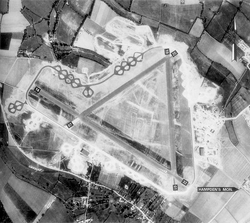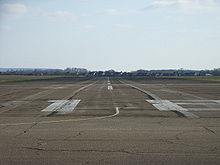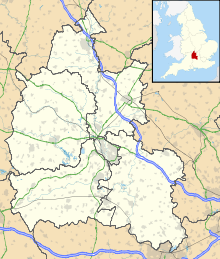- Chalgrove Airfield
-
Chalgrove Airfield 
Chalgrove Airfield - 22 April 1944, about six weeks prior to D-Day. IATA: none – ICAO: EGLJ Summary Airport type Private Operator Martin-Baker Aircraft Company Ltd Serves Oxford Location Chalgrove Elevation AMSL 240 ft / 73 m Coordinates 51°40′29″N 001°04′51″W / 51.67472°N 1.08083°WCoordinates: 51°40′29″N 001°04′51″W / 51.67472°N 1.08083°W Map Location in Oxfordshire Runways Direction Length Surface m ft 06/24 1,325 4,347 Asphalt 13/31 1,830 6,004 Asphalt 18/36 1,276 4,186 Asphalt Sources: UK AIP at NATS[1]  Chalgrove Airfield, looking southwards down the length of one of the runways with the Chalgrove village behind.
Chalgrove Airfield, looking southwards down the length of one of the runways with the Chalgrove village behind.
Chalgrove Airfield (ICAO: EGLJ) is a former World War II airfield in Oxfordshire, England. The airfield is located approximately 3 mi (4.8 km) north-northeast of Benson; about 42 mi (68 km) north-northwest of London.
Opened in 1943, it was used by both the Royal Air Force and United States Army Air Force. During the war it was used primarily as a combat Reconnaissance airfield. After the war it was closed in late 1946.
Today, the airfield is primarily used by the Martin-Baker company for testing ejector seats.
Contents
Overview
Chalgrove Airfield was one of 16 airfields west of London and south of Oxford built to bomber standards for use by American transport or reconnaissance units, and was constructed in 1943 primarily by Alfred McAlpine.
The airfield conformed to the Class A airfield standard, the main feature of which was a set of three converging runways each containing a concrete runway for takeoffs and landings, optimally placed at 60 degree angles to each other in a triangular pattern. It had a 6,004 ft (1,830 m) main runway (13/31) and secondary runways of 4,347 ft (1,325 m) (06/24) and 4,186 ft (1,276 m) (18/36) respectively. 50 hardstands were also constructed of standard loop type along with two T-2 hangars connecting to an enclosing perimeter track, of a width of 50 ft (15 m).
The ground support station was constructed largely of Nissen huts of various sizes. The support station was where the group and ground station commanders and squadron headquarters and orderly rooms were located. Also on the ground station were where the mess facilities; chapel; hospital; mission briefing and debriefing; armory and bombsite storage; life support; parachute rigging; supply warehouses; station and airfield security; motor pool and the other ground support functions necessary to support the air operations of the group. These facilities were all connected by a network of single path support roads.
The technical site, connected to the ground station and airfield consisted of at least two T-2 type hangars and various organizational, component and field maintenance shops along with the crew chiefs and other personnel necessary to keep the aircraft airworthy and to quickly repair light and moderate battle damage. Aircraft severely damaged in combat were sent to repair depots for major structural repair. The Ammunition dump was located on the northwest side of the airfield, outside of the perimeter track surrounded by large dirt mounds and concrete storage pens for storing the aerial bombs and the other munitions required by the combat aircraft.
Various domestic accommodation sites were constructed dispersed away from the airfield, but within a mile or so of the technical support site, also using clusters of Maycrete or Nissen huts. The Huts were either connected, set up end-to-end or built singly and made of prefabricated corrugated iron with a door and two small windows at the front and back. They provided accommodation for 2,557 personnel, including communal and a sick quarters
The RAF opening party arrived on 21 November 1943 and the airfield was first opened in January 1944 when the first US personnel arrived.
USAAF use
Chalgrove was allocated to the USAAF by the Ministry of Defence on 1 November 1942. The station's proximity to the RAF photographic reconnaissance base at RAF Benson and the Eighth Air Force's similar installation at RAF Mount Farm earmarked the base for the photoreconnaissance mission of the Ninth Air Force.
It was known as USAAF Station AAF-465 for security reasons by the USAAF during the war, and by which it was referred to instead of location.
10th Reconnaissance Group
The first residents of the airfield was the 10th Reconnaissance Group which arrived from Key Field, Mississippi in January 1944. The group consisted of the following operational squadrons:
- 15th Tactical Reconnaissance Squadron
- 30th Photographic Reconnaissance
- 31st Photographic Reconnaissance
- 33d Photographic Reconnaissance
- 34th Photographic Reconnaissance
- 423d/155th Photographic Reconnaissance
The 30th Photographic Reconnaissance Squadron (PRS) arrived in January and early February. The 31st, 33rd and 34th PRS became operational at Chalgrove in April.
The primary aircraft flown by the group consisted of photographic versions of the P-38 Lightning (F-5) and P-51 Mustang (F-6). In addition the unit also flew the Stinson L-1 Vigilant and L-5 Sentinel along with the Piper L-4 Grasshopper light observation aircraft.
The group photographed airfields, coastal defences, ports, and made bomb-damage assessment photographs of airfields, marshalling yards, bridges, and other targets in preparation for the Normandy invasion. The 10th received a Distinguished Unit Citation for flying at low altitude to photograph the English Channel coast from Blankenberge to Dunkirk and from Le Touquet to Saint-Vaast-la-Hougue prior to the D-Day invasion during 6 May 1944 – 20 May 1944.
In May 1944 the 30th PRS moved to RAF Middle Wallop and it was replaced by the 423rd Night Fighter Squadron with A-20 Havocs (F-3A) from RAF Charmy Down which was used for night photo reconnaissance. In June the 423d was renamed the 155th Photo Reconnaissance Squadron.
The group paved the way for the Normandy landings by carrying-out low-level "dicing" reconnaissance missions of beach approaches in May, 1944 and further supported the Normandy invasion in June by making visual and photographic reconnaissance of bridges, artillery, road and railway junctions, traffic centres, airfields, and other targets. A deployment re-apprasial in June 1944 led to the decision to assign a tactical recon squadron to support the needs of the ground forces on the continent. To this end, the 15th Tactical Photographic Reconnaissance Squadron was transferred in from RAF Middle Wallop on 27 June flying F-6/P-51B Mustangs. The mission of the 15th TPRS was to fly low level missions whereas the F-5 Lightnings would fly at higher altitudes.
After the invasion the 15th TPRS moved into France first, to the Advanced Landing Ground at Rennes - St-Jacques, France (ALG A-27) on 10 July. The other squadrons of the 10th moved over the next few weeks, the last being the 155th which moved to France in mid-August.
On the continent, the 10th RG aided the US Third Army and other Allied organizations in the battle to breach the Siegfried Line, September–December 1944. The group participated in the Battle of the Bulge, December 1944-January 1945, by flying reconnaissance missions in the combat zone. From February 1945 to V-E Day, the 10th RG assisted the advance of Third Army across the Rhine, to Czechoslovakia and into Austria, eventually being stationed at Fürth, Germany (ALG R-30) when hostilities ended.
The 10th remained in Germany after the war as part of the army of occupation, being assigned to United States Air Forces in Europe. It was transferred without personnel or equipment back to the United States in June 1947, becoming part of Tactical Air Command.
In August 1959, the United States Air Force 10th Tactical Reconnaissance Wing, the successor to the USAAF 10th Reconnaissance Group, returned to the United Kingdom, being assigned to RAF Alconbury in Cambridgeshire where it performed reconnaissance missions throughout the Cold War until being relieved and transferred to the United States in 1994.
IX Troop Carrier Pathfinder Group (Provisional)
The IX Troop Carrier Pathfinder Group (Provisional) was formed within the 52nd Troop Carrier Wing to provide accurate guidance for the airborne troops to their drop zones (DZ) and landing zones (LZ). The group was stationed at RAF North Witham, however the airfield was becoming overcrowded. The unit was moved to Chalgrove in September 1944 with its flying squadrons and associated units.
Pathfinder troop carrier crews and airborne troops were trained with radar transponder systems that were utilized as a navigational aid for incoming troop carrier serials. Parachutists were dropped with portable responder beacons that were placed on a drop zone or landing zone on the ground and after it was activated, it indicated its approximate location of the DZ/LZ on a receiver called Rebecca in the cockpit of inbound C-47s of the main airborne force.
From September 1944 though March 1945 the group airlifted supplies from Chalgrove to the continent and provided pathfinder duties to support Operation Market Garden in Holland and the airborne invasion of Germany across the Rhine (Operation Varsity). It then moved on into France. This ended the Ninth Air Force's association with Chalgrove.
25th Bombardment Group (Reconnaissance)
In August 1944 the 653d Bombardment Squadron of the 25th Bombardment Group based at RAF Watton moved to Chalgrove. The 653d was an Eighth Air Force unit equipped with special weather reconnaissance Mosquito PRXVI's which operated over the waters adjacent to the British Isles and occasionally to the Azores to obtain meteorological data. The squadron also flew over mainland Europe for weather information needed in planning operations.
In November 1945 the squadron was inactivated.
7th Reconnaissance Group
In March 1945 the 13th, 14th and 22nd Photographic Reconnaissance Squadrons from the VII Air Service Command 7th Reconnaissance Group moved to Chalgrove from RAF Mount Farm flying P-51 Mustangs (F-6). Initially the group carried out photographic mapping missions for ground forces advancing across Germany, then took part in the final bomb-damage assessments following V-E Day.
Fuselage codes for the 13th PRS was "ES" and "G2" for the 22d. The unit also flew the Stinson L-5 Sentinel light observation aircraft.
The group was inactivated at the 4th Strategic Air Depot (Hitcham) on 21 November 1945.
RAF use
With the inactivation of the 25th Bomb Group, the USAAF returned the airfield to the RAF on 1 December 1945. During the late summer of 1946, the RAF No. 8 Operational Training Unit (OTU) used the facilities to train Spitfire and Mosquito photo-reconnaissance pilots and navigators. However the use was brief and Chalgrove was closed in the autumn.
Civil use
With the end of military control, Chalgrove Airfield was leased by the MoD to Martin-Baker in July 1946 for development and testing of ejection seats. Today the airfield is surrounded by very high fences and access is restricted. Although most of the hardstands have been removed over the years, all of the runways and perimeter track exist and are still in use by Martin-Baker. Two of the wartime T-2 hangars are in use as part of the airfield and the Monument Industrial Estate site just to the southeast of the airfield contains some old USAAF buildings that were once part of the airfield.
Chalgrove Aerodrome has a CAA Ordinary Licence (Number P683) that allows flights for the public transport of passengers or for flying instruction as authorised by the licensee (Martin Baker (Engineering) Limited). The aerodrome is not licensed for night use[2].
Chalgrove in the media
Chalgrove featured in an episode of the British TV series The Professionals, the Cessna 172 being used by an escapee supposedly crashing into an airfield building. An episode of the cult series The Prisoner also featured Chalgrove, including sequences involving a Martin Baker Gloster Meteor.
See also
References
Other sources
 This article incorporates public domain material from websites or documents of the Air Force Historical Research Agency.
This article incorporates public domain material from websites or documents of the Air Force Historical Research Agency.- Freeman, Roger A. (1994) UK airfields of the Ninth: then and now, London : Battle of Britain Prints International, ISBN 0-900913-80-0
- Maurer, Maurer (1983) Air Force combat units of World War II, Washington, D.C. : Office of Air Force History, ISBN 0-912799-02-1
- Truman, Robert (2006) RAF Chalgrove airfield, Control Towers.co.uk, www web site [accessed 30 July 2007]
External links
- Martin-Baker Aircraft Company Ltd
- Chalgrove village
- 30th Photo Reconnaissance Sqdrn
- 33rd Photo Reconnaissance Sqdrn
- 34th Photo Reconnaissance Sqdrn
Stations Ben Gardane · Bou Grara · Chekira · Hani · Hazbub · Hergla · El Djem · El Haouaria · Kairouan · Medenine · Menzel Heurr · Sfax · SoltaneUnited Kingdom Aldermaston · Andover · Andrews Field · Ashford · Balderton · Barkston Heath · Beaulieu · Birch · Bisterne · Boreham · Bottesford · Boxted · Charmy Down · Chalgrove · Chilbolton · Chipping Ongar · Christchurch · Cottesmore · Earls Colne · Exeter · Folkingham · Fulbeck · Gosfield · Great Dunmow · Greenham Common · Grove · High Halden · Headcorn · Holmsley South · Hurn · Ibsley · Kingsnorth · Langar · Lashenden · Little Walden · Lymington · Matching · Membury · Merryfield · Middle Wallop · North Witham · Ramsbury · Rivenhall · Saltby · Scorton · Staplehurst · Spanhoe · Stansted · Stoney Cross · Thruxton · Upottery · Warmwell · Welford · Weston Zoyland · Wethersfield · Winkton · WoodchurchEurope Advanced Landing Grounds (ALGs) in France, Belgium, Netherlands and Germany too numerous.
Units Commands 9th Air Division (was IX Bomber Command) · IX Air Defense · IX Fighter · IX Tactical Air · IX Troop Carrier · XIX Tactical Air · XXIX Tactical AirWings Bombardment 97th Bombardment · 98th Bombardment · 99th BombardmentFighter 8th Fighter · 9th Fighter · 70th Fighter · 71st Fighter · 84th Fighter · 100th Fighter · 303d FighterTroop Carrier 50th Troop Carrier · 52d Troop Carrier · 53d Troop CarrierGroups Bombardment 12th Bombardment · 98th Bombardment · 322d Bombardment · 323d Bombardment · 340th Bombardment · 344th Bombardment · 376th Bombardment · 386th Bombardment · 387th Bombardment · 391st Bombardment · 394th Bombardment · 397th Bombardment · 409th Bombardment · 410th Bombardment · 416th BombardmentFighter 36th Fighter · 48th Fighter · 50th Fighter · 57th Fighter · 79th Fighter · 324th Fighter · 354th Fighter · 358th Fighter · 365th Fighter · 362d Fighter · 363d Fighter · 366th Fighter · 367th Fighter · 368th Fighter · 370th Fighter · 371st Fighter · 373d Fighter · 404th Fighter · 405th Fighter · 406th Fighter · 474th FighterTroop Carrier 61st Troop Carrier · 313th Troop Carrier · 314th Troop Carrier · 315th Troop Carrier · 316th Troop Carrier · 349th Troop Carrier · 434th Troop Carrier · 435th Troop Carrier · 436th Troop Carrier · 437th Troop Carrier · 438th Troop Carrier · 439th Troop Carrier · 440th Troop Carrier · 441st Troop Carrier · 442d Troop Carrier · IX Troop Carrier Pathfinder (Provisional)Reconnaissance Squadrons Liaison 14th Liaison · 47th LiaisonNight Fighter 422d Night Fighter · 425th Night FighterUnited States Army Air Forces
First · Second · Third · Fourth · Fifth · Sixth · Seventh · Eighth · Ninth · Tenth · Eleventh · Twelfth · Thirteenth · Fourteenth · Fifteenth · TwentiethCategories:- Airports in England
- Transport in Oxfordshire
- Airfields of the VIII Air Service Command in the United Kingdom
- Airfields of the IX Fighter Command in the United Kingdom
Wikimedia Foundation. 2010.



